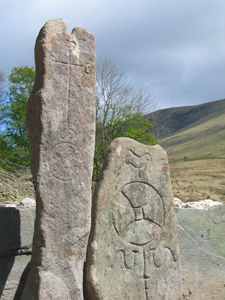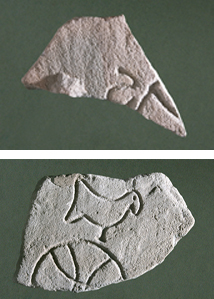Caherlehillan
.png)
CAHERLEHILLAN, CO. KERRY
Townland: Caherlehillan; Parish: Killinane; Barony: Iveragh; SMR Ref: KE070-043
| Overview |
The ecclesiastical site at Caherlehillan is located in western Iveragh, in the early medieval kingdom of Corca Duibne. It was the subject of excavation between 1992-2004 as a UCC training excavation. The site, which is not attributed to any recorded patron or founder, presented as a small sub-circular enclosure containing the remains of a shrine and two cross-inscribed stones.
The excavation demonstrated that the earliest activity on the site, focused in the period encompassing the mid-5th to early 6th centuries, was the construction of drainage features, demonstrating that forward planning had been invested in it. The enclosure and a wooden church were shown to be primary features. The church was furnished with a wooden table-altar, supported on a single post, similar to the altar depicted on the Paul and Antony scene on the Kilnaruane pillar stone. On the south side-wall of the church was a drain, presumably a sacrarium. This is the earliest dated church from Ireland and it is the most complete wooden example in terms of its liturgical features, namely the altar and sacrarium.
Most of the eighteen graves in the cemetery were aligned on the long-axis of the church and were obviously contemporary with its period of usage. One of the earliest had features that served to distinguish it from the others, including the tooling of its lintels, the inclusion in it of a rough stone cross and the positioning of a later shrine almost directly over it, suggesting that it was a ‘special’ grave. This was presumably that of the site’s founder, who was probably conceived of as a ‘saint’. What followed the burial presumably involved some form of veneration of the grave, and it appears to provide evidence for the existence of the cult of the founder’s grave in Ireland prior to the development of the more formal phenomenon that involved the ritual processes of translatio and enshrinement in tombs, which does not appear to have been common before the late 7th century. At some later stage there was a structural elaboration of the grave when a stone shrine was constructed over it.
The shrine, of corner-post type, differs in orientation from those of the earlier graves and church, suggesting that by the time of its construction a second church may have replaced the first. It essentially consisted of a box, with sides and upper surface formed of large sandstone slabs, and an upright pillar at each corner. Its interior was empty, save for its earthen core, and it seems to have been deemed unnecessary to subject the founder’s remains to the process of translatio bymoving them into this highly visible structure. In this sense the shrine is very different from the gable-shrines found elsewhere on the Iveragh peninsula, which appear to have functioned as reliquaries per se. It may have been constructed during the 8th century, the period to which corner-post shrines are generally assigned on art-historical evidence, or perhaps somewhat earlier.
Two cross-inscribed slabs stood on the site, and fragments of further examples were discovered during the excavation. One of the complete examples features an encircled Maltese cross set on a linear stem with ornamental expansions, its overall form representing the flabellum,the liturgical fan of the early Eastern Church. Above the encircled cross is the stylized profile of a bird, which may be identified as a simplified representation of the peacock, a common Christian symbol which had a strong and particular association with the flabellum. The entire iconographical background of the arrangement on this slab is Mediterranean, and fragments of two further slabs with the same decorative scheme derive from the site. On art-historical grounds they can be dated to the 6th or 7th centuries, but it is a matter of debate whether these motifs arrived in south-west Ireland direct from the Mediterranean or through continental contacts. The presence of B-ware pottery at the site, however, represents a tangible link between it and the eastern Mediterranean.
Caherlehillan is a site that dates to the formative period of Ireland’s Christianization. There is no evidence for its functioning as a formal ecclesiastical entity beyond the 8th century. It is clear, however, that it was conceived of at its planning stage as an enclosed church with a domestic sector, and that its development as a cemetery followed very soon afterwards. The picture that emerges is one of a structured site that is the antithesis of the model of organically evolving site development that is sometimes postulated.
| Further Reading |
- Sheehan, J. (2014) ‘Caherlehillan: art and architecture’, in R. Moss (ed), The Art and Architecture of Ireland, vol. 1. The Medieval Period c.400-1600, Yale University Press, pp. 132-133.
- Sheehan, J. (2014) ‘Caherlehillan: ritual, domestic and economic aspects of a Corcu Duibne ecclesiastical site’, in C. Corlett and M. Potterton (eds), The Church in Early Ireland, Dublin, pp. 247-258.
- Sheehan, J. (2013) ‘Fragmente von steinplatted mit kreuzen, Keramikscherben spatromische amphore, in C. Stiegemann, M. Kroker and W. Waler (eds), Credo: Christianisierung Europas im Mittelalter, Petersberg, pp. 218-220.
- Sheehan, John, ‘A peacock’s tale: excavations at Caherlehillan, Iveragh, Ireland’, in Nancy Edwards (ed), The Archaeology of the Early Medieval Celtic Churches, Society for Medieval Archaeology Monograph 29 (Leeds, 2009), 191-206.
 |
 |
|---|
